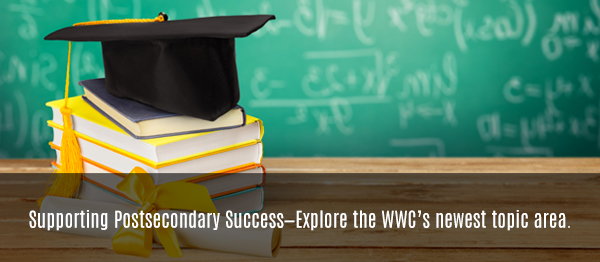By Vanessa Anderson, Research Scientist, NCEE
The What Works Clearinghouse (WWC) was founded in 2002 and, in its first decade, focused mainly on reviewing studies of programs, policies, products and practices—or interventions—for improving student outcomes in pre-K, elementary and secondary schools. But in 2012, the WWC broadened its focus and has been using rigorous standards to review studies of interventions designed to increase the success of students in postsecondary education.

This week, the WWC launches a new topic—Supporting Postsecondary Success—and it is a good time to look at the work we’re doing, and will do, in the postsecondary area.
The WWC postsecondary topic area includes reviews of studies on a wide range of interventions, including learning communities, summer bridge programs, multi-faceted support programs, academic mentoring, and interventions that aim to reduce performance anxiety. As of today, 294 postsecondary studies have been reviewed by the WWC. Those reviews are summarized in six Intervention Reports, 25 Single Study Reviews, and four Quick Reviews. And there’s much more in the works! For instance, a WWC Educator’s Practice Guide that includes strategies for supporting students in developmental education is planned for publication later this year. (Learn more about Practice Guides)
Identifying Studies for Review
In the postsecondary topic area, there are currently three main ways that studies are identified by the WWC for review.
The first is studies that are reviewed for WWC Intervention Reports. All WWC Intervention Reports use a systematic review process to summarize evidence from all available studies on a given intervention. The WWC conducts a broad search for all publicly available studies of interventions that are related to the topic. This process often identifies hundreds of studies for review. The effectiveness studies are then reviewed against WWC standards. Only the highest quality studies are summarized in an Intervention Report.
We released two new intervention reports this week as part of our new Supporting Postsecondary Success topic. You can view the new Intervention Reports on Summer Bridge programs and first-year experience courses on the WWC website.

The second way that studies are reviewed by the WWC is through Quick Reviews, which are performed on studies that have received a great deal of media attention. In these reports, the WWC provides a brief description of the study, the author-reported results, and a study rating. We like to think of Quick Reviews as a way to help people decide whether to fully believe the results of a study, based on the research design and how the study was conducted. For example, we released a quick review earlier this month that focused on a study of computer usage and student outcomes for a class at the U.S. Military Academy at West Point.
Finally, the WWC reviews postsecondary studies submitted as supporting evidence for discretionary grant competitions funded by the U.S. Department of Education, such as the Strengthening Institutions Program, First in the World and TRIO Student Support Services. These grant competitions require applicants to submit studies as evidence of the effectiveness of the interventions they propose to implement. The WWC reviews these studies and includes the results of those reviews in our database.
If you want to see all the studies on postsecondary interventions that have been reviewed by WWC you can check out—and download—the Reviewed Studies Database. In the “Topic Areas” dropdown menu, just select “Postsecondary,” and then easily customize the search by rating, publication type, and/or reasons for the review (such as a grant competition).
For more information, visit the WWC postsecondary topic area on the website. To stay up-to-date on WWC news, information, and products, follow us on Facebook, Twitter and sign up for the WWC newsflash!